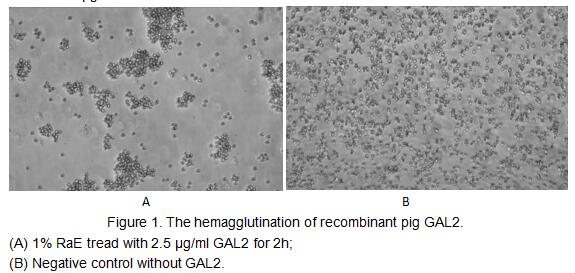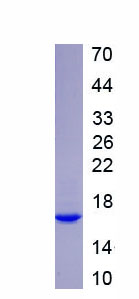Active Galectin 2 (GAL2) 

LGALS2; HL14; Lectin,Galactoside-Binding Soluble 2; Beta-galactoside-binding lectin L-14-II; Lactose-binding lectin 2; S-Lac lectin 2
- UOM
- FOB US$ 337.00 US$ 842.00 US$ 1,684.00 US$ 5,052.00 US$ 12,630.00
- Quantity
Overview
Properties
- Product No.APA302Po01
- Organism SpeciesSus scrofa; Porcine (Pig) Same name, Different species.
- ApplicationsCell culture; Activity Assays.
Research use only - DownloadInstruction Manual
- CategoryInfection immunity
- Buffer FormulationPBS, pH7.4, containing 0.01% SKL, 1mM DTT, 5% Trehalose and Proclin300.
- Traits Freeze-dried powder, Purity > 90%
- Isoelectric Point6.9
Sign into your account
Share a new citation as an author
Upload your experimental result
Review

Contact us
Please fill in the blank.
Activity test

Galectin 2 (GAL2) belongs to the proto type group and consists of two homologous carbohydrate recognition domains (CRDs) resulting in multiple sugar binding sites. The expression of gal-2 has been shown to be involved in processes of angiogenesis and inflammation but was not analyzed before in preeclamptic (PE) placentas.It also can agglutinate red blood. In this case, chose rabbit erythrocyte (RaE) to assay its ability of agglutination. A general procedure for hemagglutination assay (or haemagglutination assay; HA) is as follows, two-fold dilute the recombinant pig GAL2 with 0.9% sodium chloride injection, add 50μL a serial dilution of GAL2 to each well of a U or V-bottom shaped 96-well microtiter plate. The final well serves as a negative control without GAL2, replace with 50μL 0.9% sodium chloride injection. Then add 50μL 1% rabbit erythrocyte to each well and mixed gently. The plate is incubated for 3 hours at room temperature. The results are shown in Figure 1. It was obvious that the minimal effective concentration of GAL2 is 2.5μg/ml.

Figure 2. The hemagglutination assay of GAL2 in V- bottom shaped 96-well microtiter plate
Usage
Reconstitute in 10mM PBS (pH7.4) to a concentration of 0.1-1.0 mg/mL. Do not vortex.
Storage
Avoid repeated freeze/thaw cycles. Store at 2-8°C for one month. Aliquot and store at -80°C for 12 months.
Stability
The thermal stability is described by the loss rate. The loss rate was determined by accelerated thermal degradation test, that is, incubate the protein at 37°C for 48h, and no obvious degradation and precipitation were observed. The loss rate is less than 5% within the expiration date under appropriate storage condition.
Increment services
-
 BCA Protein Quantification Kit
BCA Protein Quantification Kit
-
 Molecular Mass Marker for Protein
Molecular Mass Marker for Protein
-
 Monoclonal Antibody Customized Service
Monoclonal Antibody Customized Service
-
 Polyclonal Antibody Customized Service
Polyclonal Antibody Customized Service
-
 Protein Activity Test Experiment Service
Protein Activity Test Experiment Service
-
 Electrophoretic Mobility Shift Assay (EMSA) Experiment Service
Electrophoretic Mobility Shift Assay (EMSA) Experiment Service
-
 Buffer
Buffer
-
 Lentivirus Packaging Experiment Service
Lentivirus Packaging Experiment Service
-
 Adenovirus Packaging Experiment Service
Adenovirus Packaging Experiment Service
-
 Real Time PCR Experimental Service
Real Time PCR Experimental Service
-
 Spike RBD Protein (S-RBD)
Spike RBD Protein (S-RBD)
-
 Protein G
Protein G
-
 Protein A
Protein A
Citations
- Potential Interaction between Galectin-2 and MUC5AC in Mouse Gastric MucusPubmed: 32009121
- Galectin-2 Has Bactericidal Effects against Helicobacter pylori in a β-galactoside-Dependent MannerPubmed: 32295066







